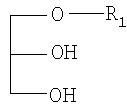FIELD: chemistry.
SUBSTANCE: method of regioselective obtainment of 1-R1-2-R2-3-acetyl-glycerol derivative of the Formula 1 involves the following stages: Obtainment of 1-R1-3-(protective group)-glycerol of Formula 3 by adding protective group to 3rd position in 1-R1-glycerol of Formula 2; obtainment of 1-R1-2-R2-3-(protective group)-glycerol of Formula 4 by adding R2 group to 2nd position of 1-R1-3-(protective group)-glycerol of Formula 3, where R2 group is added by reaction of R2-OH with 1-R1-3-(protective group)-glycerol in the presence of aprotic organic solvent, catalyst and dehydrating medium; aprotic organic solvent is selected out of group consisting of hexane, heptane, dichloromethane, ethyl acetate, tetrahydrofuran and mixes thereof; dimethylaminopyridine is catalyst; and dicyclohexylcarbodiimide is dehydration medium; simultaneous removal of protective group and acetylation of 1-R1-2-R2-3-(protective group)-glycerol of Formula 4, where protective group removal reaction and acetylation reaction are performed using Lewis acid and acetic anhydride or using acetylation agent; Lewis acid is selected out of group including zink chloride (ZnC2), tin chloride (SnCl2), boron trifluoride diethyl ether (BF3Et2O) and mixes thereof; acetylation agent is selected out of group including acetylchloride, acetylbromide and mixes thereof, where compounds of Formulae 1-4 are racemic or optically active; R1 is palmitic acid group, R2 is linoleic acid group; P is trityl or trialkylsilyl as protective group; alkyl in trialkylsilyl is an alkylic group containing 1-5 carbon atoms, so that if the protective group is trityl then 1-R1-3-(protective group)-glycerol is obtained in the presence of pyridine solvent at 40-60°C or in the presence of nonpolar aprotic organic solvent and organic base within 0°C to room temperature range; nonpolar aprotic organic solvent is selected out of group including pyridine, dichloromethane, tetrahydrofuran, ethyl acetate and mixes thereof; organic base is selected out of group including triethylamine, tributylamine, 1,8-diazabicyclo[5,4,0]-7-undecene (DBU) and mixes thereof, and if the protective group is trialkylsilyl then 1-R1-3-(protective group)-glycerol is obtained in the presence of aprotic organic solvent and organic base within 0°C to room temperature range; aprotic organic solvent is selected out of group including dichloromethane, tetrahydrofuran, ethyl acetate, dimethylformamide and mixes thereof; and organic base is selected out of group including imidazole, triethylamine, and mixes thereof. [Formula 1]  , [Formula 2]
, [Formula 2]  , [Formula 3]
, [Formula 3]  , [Formula 4]
, [Formula 4]  .
.
EFFECT: obtainment of glycerol derivative with high efficiency and output.
8 cl, 10 ex
Authors
Dates
2010-06-20—Published
2006-07-18—Filed